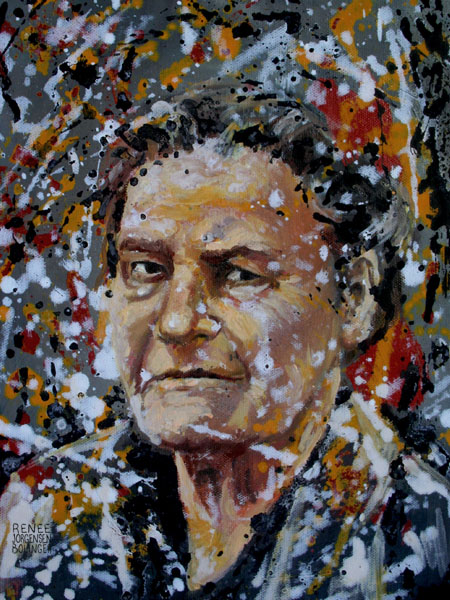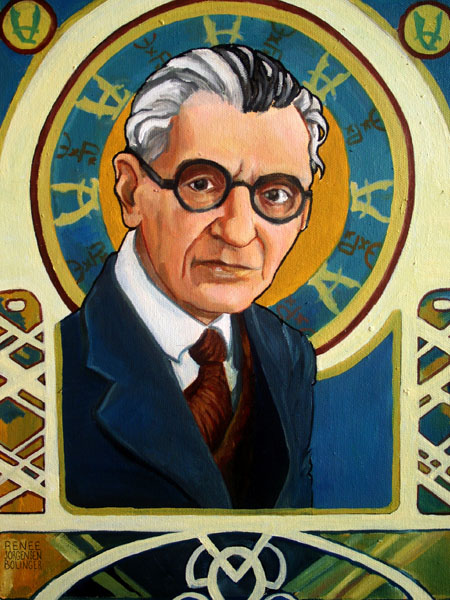[Most Recent Entries] [Calendar View]
Thursday, August 15th, 2019
| Time | Event |
| 8:00a | Philosopher Portraits: Famous Philosophers Painted in the Style of Influential Artists Ludwig Wittgenstein/Piet Mondrian: What do the Austrian-British philosopher Ludwig Wittgenstein and the Dutch painter Piet Mondrian have in common? For philosopher and artist Renée Jorgensen Bolinger, the two have similar beliefs about the logic of space. "Many of Mondrian's pieces explore the relationships between adjacent spaces," says Bolinger "and in particular the formative role of each on the boundaries and possibilities of the other. I based this painting [see above] off of Wittgenstein's Tractatus, in which he develops a theory of meaning grounded in the idea that propositions have meaning only insofar as they constrain the ways the world could be; a meaningful proposition is thus very like one of Mondrian's color squares, forming a boundary and limiting the possible configurations of the adjacent spaces." An Assistant Professor at Princeton, Bolinger studied painting a Biola University before making philosophy her second major. "I actually came to philosophy quite late in my college career," Bolinger says, "only adding the major in my junior year. I was fortunate to have two particularly excellent and philosophic art teachers, Jonathan Puls and Jonathan Anderson, who convinced me that my two passions were not mutually exclusive, and encouraged me to pursue both as I began my graduate education." Bolinger now works primarily on the philosophy of language, with side interests in logic, epistemology, mind and political philosophy. She continues to paint. We asked her how she reconciles her two passions, which seem to occupy opposite sides of the mind. "I do work in analytic philosophy," she says, "but it's only half true that philosophy and painting engage opposite sides of the mind. The sort of realist drawing and painting that I do is all about analyzing the relationships between the lines, shapes and color tones, and so still very left-brain. Nevertheless, it engages the mind in a different way than do the syllogisms of analytic philosophy. I find that the two types of mental exertion complement each other well, each serving as a productive break from the other." Bolinger has created a series of philosopher portraits, each one pairing a philosopher with an artist, or art style, in an intriguing way. In addition to Wittgenstein, she painted ten philosophers in her first series, many of them by request. They can all be seen on her web site, where high quality prints can be ordered. G.E.M. Anscombe/Jackson Pollock: Bolinger says she paired the British analytic philosopher Elizabeth Anscombe with the American abstract painter Jackson Pollock for two reasons: "First, the loose style of Pollock's action painting fits the argumentative (and organizational) style of Wittgenstein's Philosophical Investigations, which Anscombe helped to edit and was instrumental in publishing. Second, her primary field of work, in which she wrote a seminal text, is philosophy of action, which has obvious connections to the themes present in any of Pollock's action paintings." Gottlob Frege/Vincent Van Gogh: Bolinger paired the German logician, mathematician and philosopher Gottlob Frege with the Dutch painter Vincent Van Gogh as a tongue-in-cheek reference to Van Gogh's famous painting The Starry Night and Frege's puzzle concerning identity statements such as "Hesperus is Phosphorus," or "the evening star is identical to the morning star." Bertrand Russell/Art Deco: Bolinger painted the British logician and philosopher Bertrand Russell in the Art Deco style. "This pairing is a bit more about the gestalt, and a bit harder to articulate," says Bolinger. "The simplification of form and reduction to angled planes that takes place in the background of this Art Deco piece are meant to cohere with Russell's locial atomism (the reduction of complex logical propositions to their fundamental logical 'atoms')." Kurt Gödel/Art Nouveau: Bolinger paired the Austrian logician Kurt Gödel with Art Nouveau. "The Art Nouveau movement developed around the theme of mechanization and the repetition of forms," says Bolinger, "and centrally involves a delicate balance between organic shapes -- typically a figure that dominates the portrait -- and schematized or abstracted patterns, often derived from organic shapes, but made uniform and repetitive (often seen in the flower motifs that ornament most Art Nouveau portraits). I paired this style with Kurt Gödel because his work was dedicated to defining computability in terms of recursive functions, and using the notion to prove the Completeness and Incompleteness theorems." To see more of Renée Jorgensen Bolinger's philosopher portraits, click here to visit her site. Note: This post originally appeared on our site back in 2013. Would you like to support the mission of Open Culture? Please consider making a donation to our site. It's hard to rely 100% on ads, and your contributions will help us continue providing the best free cultural and educational materials to learners everywhere. Also consider following Open Culture on Facebook and Twitter and sharing intelligent media with your friends. Or sign up for our daily email and get a daily dose of Open Culture in your inbox. Related Content: A History of Philosophy in 81 Video Lectures: From Ancient Greece to Modern Times Photography of Ludwig Wittgenstein Released by Archives at Cambridge Philosopher Portraits: Famous Philosophers Painted in the Style of Influential Artists is a post from: Open Culture. Follow us on Facebook, Twitter, and Google Plus, or get our Daily Email. And don't miss our big collections of Free Online Courses, Free Online Movies, Free eBooks, Free Audio Books, Free Foreign Language Lessons, and MOOCs. |
| 11:00a | People Pose in Uncanny Alignment with Iconic Album Covers: Discover The Sleeveface Project
We've all heard a great deal over the past twenty years or so about the death of the album. This talk seems to have begun with the emergence of the downloadable individual song, a technology that would finally allow us consumers to purchase only the tracks we want to hear and avoid paying full price for "filler." But against these odds, the long-playing album has persisted: artists still record them and listeners, at least dedicated listeners, still buy them, sometimes even on vinyl.
Somehow the album has remained culturally relevant, and a fair bit of the credit must go to its cover. It didn't take long after the introduction of the 12-inch, 33 1/3-RPM vinyl record in 1948 for the marketing purposes of its large outer sleeve to become evident, and the past 71 years have produced many a memorable image in that form. Few platforms could be as representative of our digital age as Instagram, but it is on Instagram that the album cover has recently received homage from across the globe.
"Sleeveface is an amusing participatory photo project in which people from all over the world strategically pose with matching album covers," writes Laughing Squid's Lori Dorn, "creating the illusion that the original picture is complete."
Browse the tags #sleeveface and #sleevefacesunday (for everything on the internet eventually gets its day) on Instagram and you'll see a variety of tribute poses, some of them uncannily well-aligned, to musicians whose faces we all know not least because they've appeared on iconic album covers: Bruce Springsteen to Bob Marley, Simon and Garfunkel to Iggy and the Stooges, Leonard Cohen to Freddie Mercury, Janis Joplin to Adele.
All those famous names have undergone the sleeveface treatment, and quite a few of them have undergone it more than once. Many of us have grown familiar indeed with these albums, and surely even those of us who've never listened to them start-to-finish probably know at least a couple of their songs. But even if you've never heard so much as a measure of any of them, you've almost certainly seen their covers — and may well, at one time or another, have been tempted to hold them up in front of your own face to see how they lined up. Popular music shows us how much we have in common, but so does its packaging.
via Laughing Squid Related Content: Classic Jazz Album Covers Animated & Brought to Life The Groundbreaking Art of Alex Steinweiss, Father of Record Cover Design Based in Seoul, Colin Marshall writes and broadcasts on cities, language, and culture. His projects include the book The Stateless City: a Walk through 21st-Century Los Angeles and the video series The City in Cinema. Follow him on Twitter at @colinmarshall or on Facebook. People Pose in Uncanny Alignment with Iconic Album Covers: Discover The Sleeveface Project is a post from: Open Culture. Follow us on Facebook, Twitter, and Google Plus, or get our Daily Email. And don't miss our big collections of Free Online Courses, Free Online Movies, Free eBooks, Free Audio Books, Free Foreign Language Lessons, and MOOCs. |
| 4:24p | Watch John Entwistle’s Bass-Playing Genius on Display in Isolated Tracks for “Won’t Be Fooled Again” and “Baba O’Reilly” I guess it’s easy to be “The Quiet One” in The Who when surrounded by a preening singer with golden locks, a guitarist with a windmill arm who smashes his equipment, and a completely insane drummer (on and off stage). But John Entwistle helped root the band by standing still and delivering some of the meatiest and beatiest licks and melodic runs in ‘60s rock. The above footage salvaged from the doc The Kids Are Alright shows the master at work. “Won’t Be Fooled Again” isn’t known as a bass-forward song, so this isolated track from a live take show will make you hear it anew. Entwistle plays his bass like an electric lead, doubling the drums sometimes, other times mimicking the vocals. He plays triplets and runs. He zooms up the neck, slides down, arpeggiates, the lot. It’s thick. Just hit play. As some YouTube wag points out, it’s something of a bass player joke come to life at the end, where Entwistle leaves his bass onstage and walks off, while a girl rushes out of the audience to embrace the lead singer. Such is life in a band. From the same shoot, you can also check out his isolated bass from “Baba O’Reilly.” Entwistle has a three-note riff to work with. He stays true to it while filling in spaces here and there with distortion turned way up. At the end he has a sip of (I assume) water and looks about as excited as when he started. In the mid-nineties, Entwistle was interviewed for a book on drummer Keith Moon. Author Tony Fletcher caught him in an honest mood:
Not all rock bands consist of best friends, and some are downright rancorous. But that’s often what brings out the best in people. So as you gaze at Entwistle stifling a yawn during these two clips, consider his confession and enjoy. Related Content: The Neuroscience of Bass: New Study Explains Why Bass Instruments Are Fundamental to Music Listen to Grace Slick’s Hair-Raising Vocals in the Isolated Track for “White Rabbit” (1967) What Makes Flea Such an Amazing Bass Player? A Video Essay Breaks Down His Style Ted Mills is a freelance writer on the arts who currently hosts the artist interview-based FunkZone Podcast and is the producer of KCRW's Curious Coast. You can also follow him on Twitter at @tedmills, read his other arts writing at tedmills.com and/or watch his films here. Watch John Entwistle’s Bass-Playing Genius on Display in Isolated Tracks for “Won’t Be Fooled Again” and “Baba O’Reilly” is a post from: Open Culture. Follow us on Facebook, Twitter, and Google Plus, or get our Daily Email. And don't miss our big collections of Free Online Courses, Free Online Movies, Free eBooks, Free Audio Books, Free Foreign Language Lessons, and MOOCs. |
| 7:00p | A Short Animated Introduction to Hypatia, Ancient Alexandria’s Great Female Philosopher Ten years ago, a film came out called Agora, a biopic of philosopher and mathematician Hypatia of Alexandria, daughter of mathematician Theon, the last recorded director of the Library of Alexandria. The movie wasn’t well-reviewed or widely seen, which is neither here nor there, but it was heavily criticized for historical inaccuracies. This seemed a little silly. “One does not go to the movies to learn about ancient history but to be entertained,” as Joshua J. Mark writes at the Ancient History Encyclopedia. Agora is not an accurate rendering of the little we know of Hypatia, but neither is Spartacus, a far more entertaining film, an accurate depiction of the 2nd century B.C.E. gladiator and rebel. And yet, we should know who Hypatia was, and we should understand what happened to her, something many of the film’s religiously-motivated critics refused to admit, claiming that the depiction of hostile, anti-intellectual Christians in the movie was nothing more than prejudicial animus on the part of director Alejandro Amenabar. The truth is that “the anti-intellectual stance of the early church is attested to by early Christian writers,” Mark points out. And “the historical records state” that Hypatia “was beaten and flayed to death by a mob of Christian monks who then burned her in a church.” The TED-Ed video above calls this mob a “militia” who saw Hypatia’s scientific pursuits as “witchcraft.” The charge is, of course, specifically gendered. The manner of her death was so brutal and shocking that “even those Christian writers who were hostile to her and claimed she was a witch,” Mark writes, “are generally sympathetic in recording her death as a tragedy. These accounts routinely depict Hypatia as a woman who was widely known for her generosity, love of learning, and expertise in teaching in the subjects of Neo-Platonism, mathematics, science, and philosophy.” As is the case with many ancient figures, none of her own writings survive, but both her contemporary critics and sympathetic students record similar impressions of her intellectual curiosity and scientific knowledge. The short video lesson tells us Hypatia was born around 355 A.C.E., which means she would have been around sixty years old at the time of her death. She lived in Alexandria, “then part of the Egyptian province of the Eastern Roman Empire, and an intellectual center.” Educated by her father, she surpassed him “in both mathematics and philosophy, becoming the city’s foremost scholar.” She eventually succeeded Theon as head of the Platonic school, “similar to a modern university,” and she served as a trusted advisor to the city’s leaders, including its governor, Orestes, a “moderate Christian” himself. Her achievements were many, but her teaching, drawing on Plato, Aristotle, Plotinus, and Pythagoras, was her greatest legacy, the TED-Ed lesson (scripted by Soraya Field Fiorio) asserts. Hypatia’s death not only deprived the city of a beloved teacher and scholar. Her murder, at the behest of Alexandrian bishop Cyril, “was a turning point.” Other philosophers fled the city, and Alexandria’s “role as a center of learning declined.” “In a very real way,” the lesson tells us, “the spirit of inquisition, openness, and fairness she fostered died with her.” For a more complete treatment of Hypatia's life and intellectual contributions, read Maria Dzielska's book, Hypatia of Alexandria. Related Content: The Rise and Fall of the Great Library of Alexandria: An Animated Introduction Free Courses in Ancient History, Literature & Philosophy Josh Jones is a writer and musician based in Durham, NC. Follow him at @jdmagness A Short Animated Introduction to Hypatia, Ancient Alexandria’s Great Female Philosopher is a post from: Open Culture. Follow us on Facebook, Twitter, and Google Plus, or get our Daily Email. And don't miss our big collections of Free Online Courses, Free Online Movies, Free eBooks, Free Audio Books, Free Foreign Language Lessons, and MOOCs. |
| 9:46p | Listen Online to Every Minute of the Original Woodstock Festival
Image of Joe Cocker by Derek Redmond and Paul Campbel, via Wikimedia Commons Lifehacker has this great tip. "Starting at 5:07 p.m. EST today, August 15, you can listen to every minute of the three days of concerts, courtesy of Philadelphia radio station WXPN. It will include all of the festival’s archived audio: from the iconic performances to the stage announcements to the rain delays. The exclusive broadcast will feature newly reconstructed audio archives of each of Woodstock’s 32 acts, starting with Richie Havens’ opening set, and continuing through to Jimi Hendrix’s closing performance on Sunday morning. According to a release from the station, it will be broadcast in as close to real time as possible.” To listen, go to this page, scroll down, and launch the media player. Would you like to support the mission of Open Culture? Please consider making a donation to our site. It's hard to rely 100% on ads, and your contributions will help us continue providing the best free cultural and educational materials to learners everywhere. Also consider following Open Culture on Facebook and Twitter and sharing intelligent media with your friends. Or sign up for our daily email and get a daily dose of Open Culture in your inbox. Listen Online to Every Minute of the Original Woodstock Festival is a post from: Open Culture. Follow us on Facebook, Twitter, and Google Plus, or get our Daily Email. And don't miss our big collections of Free Online Courses, Free Online Movies, Free eBooks, Free Audio Books, Free Foreign Language Lessons, and MOOCs. |
| << Previous Day |
2019/08/15 [Calendar] |
Next Day >> |














